The largest compilation of information on plant viruses in Brazil was published in Biota Neotropica, featuring 219 pathogens that infect plants in Brazil, many of which are agriculturally important species. The annotated list contains descriptions of the microorganisms, data on the disease that they cause, and the vital facts on their occurrence in various plants.

The Author
The author, Elliot Watanabe Kitajima, is a researcher in the Phytopathology and Nematology Department of the University of São Paulo's Luiz de Queiroz College of Agriculture (ESALQ-USP).
According to him, he has always fancied collecting publications on plant viruses in Brazil. His collection spanned for decades, and he had recorded some 8,000 references to date.
"I eventually realized that if I were asked how many viruses have been recorded in Brazil, I wouldn't know the answer, so I drew up an alphabetic list of plant species and of the viruses that naturally infect them. I also produced a reverse list in which the viruses and viroids are followed by the plants infected by each one."
Dr.Kitajima was an agronomy graduate from ESALQ-USP in 1958. In 1967, he earned his Ph.D. at the same institution. He became a researcher at the Agronomic Institute (IAC), a professor at the University of Brasilia, and a visiting professor at ESALQ-USP. He retired in 2006.
The inventory was born out of projects conducted under the APESP Research Program on Biodiversity Characterization, Conservation, Restoration, and Sustainable Use (BIOTA-FAPESP).
READ: Deadly Zoonotic Wildlife Diseases Increase as Nature is Damaged
The importance of the virus literature
According to Carlos Joly, a professor at UNICAMP, the author has painstakingly produced an important database that is useful to researchers and even policymakers from crafting pest prevention policies.
The inventory list is also vital to economic activities. The list includes 346 plant species from 74 different families with the corresponding virus that might infect them.
For example, the citrus fruit may be affected by a virus: while many illnesses are known, some viruses remain unknown. These pathogens affect fruit production and quality. Being able to identify these viruses quickly can prevent harm and avoid losses.
Joly cites that the cristeta tristeza virus (CTV) is prominent in molecular plant pathology. The particular virus causes plants to decline quickly. It is also the most economically significant citrus disease that has inflicted all over the globe. The infection was responsible for widespread agricultural loss, which led to the destruction of approximately 10 million orange trees in the 1940s.
However, this problem was addressed through scientific research: identifying the pathogen and providing appropriate interventions accordingly. The proper identification and scientific-based intervention made Sao Paulo the largest producer and exporter of industrialized orange juice globally.
READ ALSO: Small Drought-Resilient Trees May be the Future of the Amazon Rainforest
Bean golden mosaic virus, which first emerged in the 1970s, caused Brazil to import Mexico's products due to severe losses brought about by the disease. Brazil used to be one of the world's leading bean producers before the condition.
Papaya ringspot virus (PRSV) wiped out entire populations in Brazil. The infection was controlled by roguing (systematic removal of the infected plant), which made the state of Espirito Santo, which pioneered the technique to become the major exporter of papaya.
According to Kitajima, various factors such as geography, climate, plant species or variety, vectors, and crop practices determine how hazardous viruses are. In monocultures such as plantations and genetic uniformity, viral diseases can easily spread, causing significant losses. Researchers must be prepared to offer a solution with the appropriate information, thus developing the comprehensive plant virus database.
© 2025 NatureWorldNews.com All rights reserved. Do not reproduce without permission.





